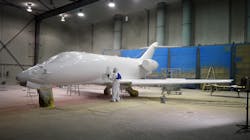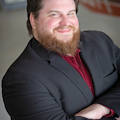Painting an aircraft can be forgiving work, especially compared to other maintenance activities. That’s not to say it’s work without craftsmanship or know-how, but it’s easier work to teach than overhauling an engine, and with the industry at large still grappling with a labor crisis, it gives MROs a wider pool of candidates to choose from.
Geoffrey Myrick, chief operating officer – USA, MAAS Aviation, said they believe in “universal opportunity” when hiring new painters.
“We frequently accept applicants and new team members without experience. We are looking for passion, professionalism and a desire to learn,” Myrick said. “Given that aircraft painting is not a licensed trade, we can recruit, hire and train a broader base of people than repair stations requiring licensed A&P mechanics. That said, whereas there are a lot of training schools and programs across the country producing new A&P mechanics each year, the same is not true for aircraft painters.”
And "learn" might be the keyword, as a novice or brand-new painter will have a lot to learn to master their new craft. It’s learning that can be done in-house at an MRO with a new hire, but knowing how to parse it out and keep bad habits from forming is critical.
Safety First
Myrick said that at MAAS, they start with safety first when training fresh hires.
“At MAAS Aviation, our number one priority is the health and safety of our team members. Ultimately, everyone’s skill progression and advancement will be unique; however, if we provide the conditions, training and expectations for people safety at work, we maintain a positive health and safety culture,” he said.
Day 1 at MAAS for trainees is therefore dedicated to a series of industrial and company-specific health and safety training sessions, conducted in person and led by their quality, health and safety manager.
Richard Giles, technical service manager, Sherwin-Williams Aerospace Coatings, recommends several safety training modules:
- Personal protective equipment (PPE)
- Health and safety
- Height access training and certification, such as scissor lifts
- Chemical stripper training, both proper use and legal disposal in accordance with state and federal guidelines.
“So, it’s all encompassing. It’s what can these things do if you don’t follow health and safety guidelines,” Giles said.
Myrick said their quality, health and safety manager at MAAS can spend eight hours or more covering the needed information and safety concerns that come with the job. There are no shortcuts to this part of training a new painter and laying this foundation sets up hires for success with the rest of their education.
“Most industrial occupations have aspects which are inherently unsafe and require mitigating action such as training, PPE, etc. and aircraft painting is no different,” Myrick said. “Always confirm you have the correct PPE, if you feel uncertain – ask for help, and if you feel unsafe for whatever reason – stop.”
After the first day’s focus on safety, on Day 2 new team members are introduced to MAAS’ 5-level training program.
“Our program is progressive and the completion of each level is recorded. Transparency is critical. By showing new team members the full program on Day 2, we ensure that they have a working understanding of how they can expect to develop at the trade ability level, i.e., skill by skill. It’s at this time that we also explain how they will be trained – a combination of classroom theoretical, semi-practical, and practical; who will train them – a shared responsibility between the training manager and senior members of the aircraft painting team; and the expected timeframes for advancement. For a new hire without experience, we map a 12-month developmental plan with a formal feedback loop every 90 days therein.”
The Fun Part
After the foundations have been laid for a new hire, it’s time to get to the fun part – painting. But it’s not all spray guns and fresh coats. One of the most challenging parts for a new hire to master is the prep work needed before paint is applied.
“Painting is the fun part, but focusing on the surface preparation is essential. 80% of our work is preparation. If the painter wants to achieve excellent standards of finishing, they first need to understand how to prepare the aircraft for painting. Dedicating the time and attention to learning surface preparation before moving into paint application is a must,” Myrick said.
Patience is key and mastering it is another challenge new painters can struggle to get down. MAAS starts new painters off in a “safe space,” where mistakes can be made and learned from.
“Test panels are great way to learn sanding and spraying technique without risk to an aircraft,” he continued. “We use a combination of electrostatic and HVLP (high volume, low pressure) spray equipment in our painting operations. Preparation activities require standard industrial tooling like mechanical disc sanders and air blow guns.”
Stefan Jaschinski, head of technical service, Mankiewicz Aviation Coatings, said it is crucial that the test painting is practiced on a large surface to have overlapping areas between the paint layers and to adjust to the paint system under actual conditions.
“This requires a substrate size of at least 1 m2; better 2 m2,” he said.
As a paint supplier, Mankiewicz repeat the basic knowledge and usually start with a two-day classroom session in which the theoretical basics are taught. The basics to painting are always the same but are adapted to the conditions at a site.
“This starts with the climatic conditions and ends with the equipment,” Jaschinski said. “On the one hand, this involves the painting equipment itself, e.g., the various spray gun settings, atomizing pressure and pump settings. On the other hand, it’s about everything to do with mixing and processing paint. This includes, for example, viscosity measurements, mixing ratios, individual pot life and much more.”
Jaschinski notes that the main challenge they see trainees encounter can initially sound relatively trivial, but it is a supreme skill – the balancing act between a perfect surface and runners.
“For the ideal film build, you have to develop a feeling; for that, you need experience,” he said.
While a soft skill, Giles stresses that knowing how to trouble shoot a project goes a long way to becoming a master painter.
“You must have basic troubleshooting skills. If something goes wrong, you have to reverse yourself out of that problem and say, ‘well, what did we do to get ourselves in this position?’ Because if you don’t know, you’ll be reworking it and having the same issue, because you don’t know why you had the issue.”
Avoiding Bad Habits
A trickier part of the new-hire process is making sure they avoid learning bad habits during the training process, whether these are self-taught or picked up from a trainer, ala the pitfalls of sharing tribal knowledge.
“If you get a young guy and he’s under the wing of a seasoned painter who has never done it really properly, that will be his mental default settings. He will always default to the wrong way. No matter what you tell him thereafter, he’ll always default to the first time he was exposed to that process,” Giles said.
To combat this at MAAS, they have kept their paint training constant over the decades while leaving room to evolve with new technology and trends in the market.
“Our program has been developed and refined over a 30-year period. It’s adapted to changes in process and technology,” Myrick said. “The constant in MAAS’ program is the standard itself. No matter how the industry evolves and changes, our expectations do not. We expect our team members to be the best aircraft painters in the world, and we structure our training and developmental programs accordingly.”
He notes that aircraft painting is a skilled trade, and skill progression and advancement are often unique to the individual.
“While the MAAS program structure and administration is very consistent, people’s ability to advance through the 5-level program is driven by their demonstrated and documented competency per trade ability,” he said.
Myrick said that their program and philosophy towards training frequently produces competent painters in six to nine months, while “fully trained” to their company standards often takes years.
“At MAAS, we consider a painter to be fully trained once they’ve demonstrated mastery over several spraying techniques on all surfaces of the aircraft and with multiple types of paint systems,” he said.
And while their process has been refined and tailored over the years, Myrick gives the following pointers an operation can adopt to produce high quality aircraft painters:
- Make sure you dedicate enough time to learning the proper procedures for surface preparation.
- Create safe spaces for practical training. Test panels are a great way to get new painters painting in a low-risk setting.
- Have trainees re-work their own mistakes. Learning how to rectify paint-related issues, like paint runs, inclusions, etc., is often the best way of learning how to prevent them.
About the Author
Walker Jaroch
Editor
Contact: Walker Jaroch
Editor | AMT
+1-920-568-8399
>> To download the AviationPros media kits, visit: Marketing Resource Center
>>Check out our aviation magazines: Ground Support Worldwide | Airport Business | Aircraft Maintenance Technology

